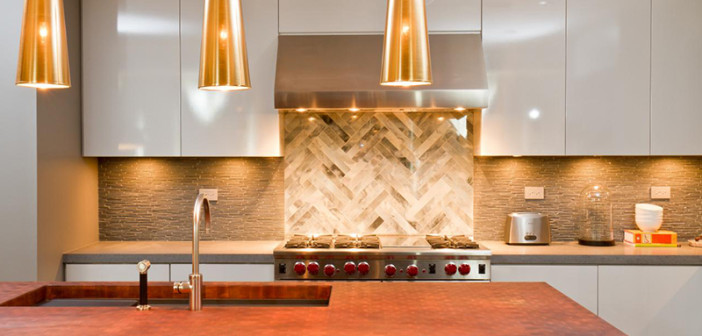Kitchen contractors save money whether you are redesigning your kitchen from scratch or replacing certain design elements. Of all the home renovations, a kitchen remodel renders the best return on investment (ROI). For a midrange home, adding a luxurious chef’s kitchen may hurt the resell value because the excessive upgrade won’t be recouped. However, if the neighbors have granite countertops and high efficiency appliances, then the investment will boost the resale value and enhance your enjoyment of the space. Upgraded kitchen are preferred by 69 percent of home buyers.
Design elements
- Cabinets are more than storage; they are design elements that set the tone for the kitchen. Cabinets for storing small kitchen appliances, pots, pans, bowls, China, and every day dishes need to be accessible and convenient. Incorporating a glass front cabinet into the décor allows showing off tea sets, serving bowls, and fine China. The most coveted cabinet is a pantry large enough for staples, cans, and spices. Cabinets that turn large appliances into seamless décor are popular. Think about how you use your kitchen before you plan your space allotment.
- Countertops are used for baking and the type of baking will determine the type of material. Marble stands up well to baking pastry and bread. Granite is attractive but needs annual maintenance. Tile is a design choice; the grout makes it a chore to keep clean. Quartz and solid surface like concrete stands up to knife work. Laminate, the least costly, is a good all-purpose countertop with low maintenance. A cutting board must be used on laminate counters.
- Appliances should be high efficiency. Black stainless looks stunning next to Golden Oak cabinets. Silver stainless offsets rosewood cabinets. For a retro feel, gold or avocado appliances summon mother’s cozy kitchen. Matching appliances add value to the design. A white stove with a stainless refrigerator is just plain unattractive. Adding a subzero freezer, wine cooler, or garbage compactor is a nice touch that also adds value.
- Flooring should be easy to clean. Spills happen in the kitchen frequently. Engineered flooring is water resistant and comes in a variety of patterns. Ceramic, porcelain, and stone tile have a great diversity for design. They are water resistant but can get slippery in high humidity. Linoleum is inexpensive and provides an easy-to-clean surface that comes in countless designs. The textured surface of linoleum is safer for mobility challenged people and does not sweat in high humidity environments.
- Lighting sets the mood of the kitchen, emphasizes focal points, and should be bright enough to make work areas safe. Usually, an overhead light fixture will provide adequate light in the room. There are two kinds of under cabinet lights: traditional hard-wired sets or remote-controlled battery-operated lights. The best kitchens are the ones that have a variety of light fixtures that coordinate with one another seamlessly. The recipe for combining bright light, ambient light and accent lighting starts with taking into consideration factors including your kitchen layout, your home’s style, and the functionality you desire. You’ll be able to set the mood in your kitchen for entertaining with the touch of a button.
Contractor services
Kitchen renovation requires a kitchen contractor to coordinate services of subcontractors and meet all New Jersey requirements.
- Demolition is more than removal of cabinets, counter tops, and appliances, it has to protect the walls and existing electrical and plumbing fixtures. If floors are to be preserved and lighting maintained, demolition needs to be responsive to those needs.
- Insulation will save money spent on electricity and save energy. Insulation also helps regulates temperature in the kitchen.
- Drywall needs to be replaced when new framing or plumbing is installed. Walls need to be sturdy, safe, and up to code so that cabinets do not fall off. The electrical plan needs to be in place before drywall is cut for electrical boxes, circuits, and fittings.
- Flooring should be installed before cabinets and appliances. Using a sub-contractor ensures the floor is level and installed correctly to stand up to high traffic and spills that a kitchen endures.
- Plumbing connections for sinks, faucets, and added fixtures like a pot filler needs to be installed next. Kitchen plumbing is different than bathroom plumbing. Kitchens deal with food waste, fats, oil, and grease. These might seem like liquids but when they cool down, they solidify and cause nasty clogs in your drains. Kitchen plumbing fixtures are attached to a home’s water supply system, as well as its drain-waste-vent (DWV) system. The water supply system brings water into the home while the DWV system removes water, waste, and provides vents for creating air pressure and releasing or blocking sewer gasses. Design choices for fixtures are diverse.
- Electrical wiring needs to have an individual circuit for each appliance in the breaker box. Electrical also needs to accommodate lighting features.
- Cabinets and countertops are installed last. Using a professional kitchen contractor ensures proper heights and placement.
Permits
Renovating your kitchen involves structural changes with electrical and plumbing work that requires permits. A professional kitchen contractor will know when to time the work with the appropriate departments in the New Jersey government. Building code inspection is handled by the Office of Construction Code which serves as a centralized location for the issuance of permits and inspections. Retain copies of the permits to protect the resale value of your home and that occupancy is permitted.

